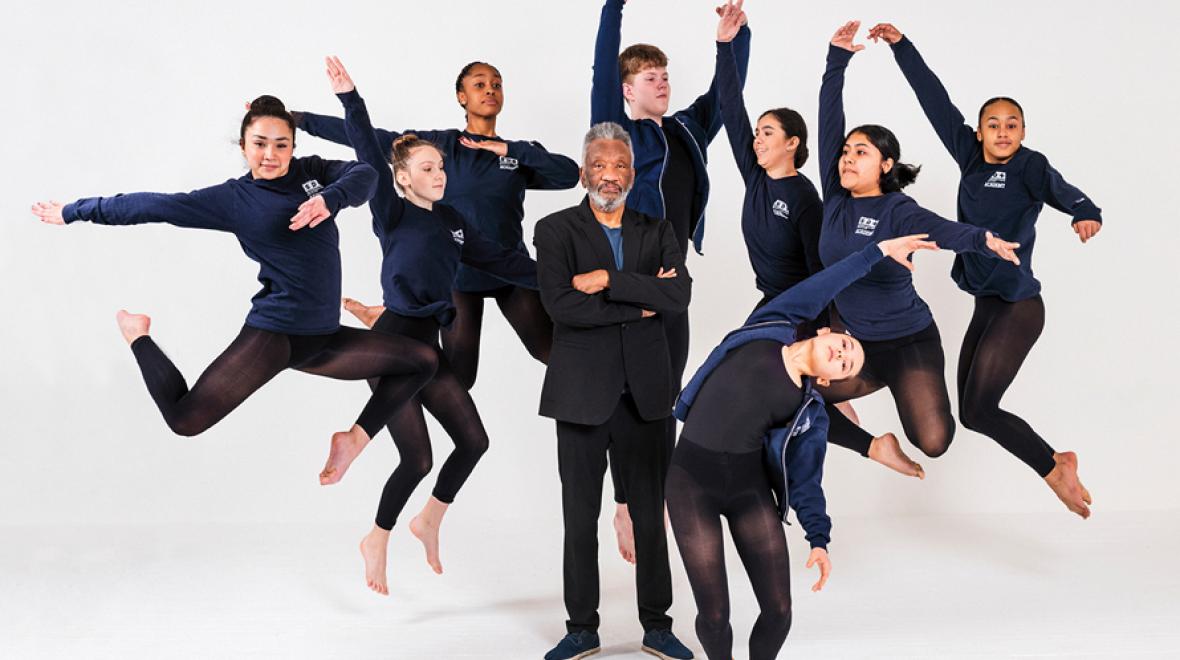
Photo:
Donald Byrd and youth dancers from Spectrum Dance Theater | Credit: Will Austin
Dancer, choreographer and teacher Donald Byrd is also frequently referred to as a “citizen artist” because of the social awareness that shines through every aspect of his career. Byrd’s conviction that dance is both an art form and a civic instrument is most visible in his choreography and in the programming he creates as artistic director for Spectrum Dance Theater. But his most lasting impact may be less immediately visible, in the programs offered by Spectrum’s dance school, where “Dance for All” is more than just a catchphrase.
Offering classes and training for beginners and professionals alike, from toddlers to seniors (“The oldest in that class is 90-plus,” Byrd says with pride), Spectrum has a focus that differs from those of many dance schools. Instead of trying to sculpt a “dancer’s body” based on a particular aesthetic, says Byrd, “The ideal body for dancing is one that moves well.” And that is something Byrd can teach to any willing student.
“Who said being skinny was a prerequisite to dance?” he asks. “I have seen a lot of skinny people on stage who can’t move. The best movers often are not the people with those kinds of bodies.”
Byrd says that at Spectrum, a student who is in financial need — no matter what their body type and even if they have absolutely no talent — can earn a scholarship. “One of the reasons Spectrum was attractive to me was that the school program was based purely on the desire to dance.”
Through the school, Byrd is working to make the dance world more accessible and equitable; through his choreography, he addresses global social issues. But the two approaches are not kept separate. A series of Byrd Technique classes introduces students to his particular approach to dance. World dance classes teach students dance techniques from cultures outside of the Eurocentric ballet tradition. Byrd personally teaches a class he calls “Engaging.” In that class, he assigns readings with social justice themes, teaches about the work of marginalized artists, and guides students through self-examination and identity exercises.
“I want them to not just be able to dance. I want them to be able to talk about dance in a couple of contexts. One of them is to talk about dance in an aesthetic context, and another is to think about dance in a civic, social context. I encourage them to think in the context of responsibility — what is their responsibility, not only to themselves and their families, but to the world at large? There’s a sense of compassionate empathy. That’s what I want for them,” he says.
The result is a supportive community culture in which students grow as dancers and as people.
“[Students] show up day after day. They like the training, the atmosphere, and the people here are friends. They’re in it together,” says Byrd. But the kids aren’t the only ones who benefit from the lessons.
“A remarkable thing happened when I started teaching kids,” says Byrd. “All the people in my life, they said, ‘Oh, you seem much nicer now!’”
What one thing did a mentor do for you as a youth that helped you succeed?
I had a lot of mentors, though I didn’t know that’s what you called them at the time. My third-grade teacher, Ms. Gonzalez, was an early one. I was a good reader, in the top group in my class, and she’d make me go help the kids in the other groups. I grew up an only child and was not particularly outgoing at that time, and she said, “I have a nephew about your same age,” and made me have playdates with him two or three times a week.
What do you wish people understood about your work?
That it is work. It’s not a hobby. It takes preparation and training and commitment. I do a lot of research. It really is work. Perhaps the only difference is that I get a lot of joy from my work.
What’s one small action readers can take in their own lives to make positive change?
Allow yourself to be passionate about something. Optimism and gratitude grow out of that.
What daily habit can you not live without?
Coffee! Also, I have to read every morning. Now it’s architecture and design publications — I have to know about what creative things other human beings are doing.
Favorite recent read?
“The Emancipated Spectator” by a French philosopher and cultural theorist named [Jacques] Rancière. Some people say that it’s difficult, but I think they’re “reading too much into it.” He’s saying what he means. The book is a call for simplicity and intentionality in communication and in life. It’s not easy, but I found it a good read — it’s worth it.
What has been the biggest change in your work in the past 10 years?
The biggest change is I’m not really interested in what people think about whether my work is good — you know, like critics in particular. Now, I’m curious, I will read them, but it’s not what drives me. I’m more confident about what it is I do. I hope people embrace it, but I know it has value. I know and believe my work is good.
What is your best advice for parents who want to support their kids to achieve big ambitions?
Wow. I listen to the kids talking here at Spectrum all the time, and we talk about their relationship with their parents. The kids in the Academy have really good support systems. I think it is this: To listen to the child. You have to give them your attention. It’s a kind of respect for them.
If you could have a superpower, what would it be?
People would do exactly what I want. What I mean is, when I’m teaching, people would know exactly what I meant and be able to do it.











